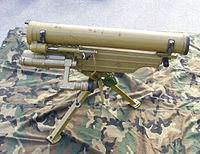| 9K115 Metis | |
|---|---|
 NATO reporting name: AT-7 Saxhorn | |
| Type | Anti-tank missile |
| Place of origin | Soviet Union |
| Service history | |
| In service | 1979 – present |
| Used by | Russia |
| Production history | |
| Manufacturer | KBP Instrument Design Bureau |
| Produced | 1978 – present |
| Variants | 9K115-2 Metis-M |
| Specifications | |
| Mass |
5.5 kg (12 lb); 6.3 kg (14 lb) w/container |
| Length | 740 mm (29 in) |
| Diameter | 94 mm (4 in) |
| Warhead | HEAT shaped charge |
| Warhead weight | 2.5 kg (5.5 lb) |
|
| |
| Wingspan | 300 mm (12 in) |
Operational range | 40–1,000 m (130–3,280 ft) |
| Maximum speed | 223 m/s (732 ft/s) |
Guidance system | Wire-guided SACLOS |
The 9K115 Metis ("mongrel") (NATO reporting name AT-7 Saxhorn) is a man-portable SACLOS wire-guided anti-tank missile system of the Soviet Union.
Development[]
The missile was developed by the Tula KBP. It is very similar to the AT-4 Spigot in external appearance - having 3 main fins - however, the missile is much lighter - primarily because of the reduced fuel load. This reduced load cuts the maximum range to 1,000 metres (3,300 ft).
During the 1980s, an upgraded version of the missile was developed - the Metis-M 9M131 (sometimes labelled Metis-2). Fired from the same launcher, the new missile is much larger and heavier, with an increased range and a larger warhead. NATO labelled this missile the AT-13 Saxhorn-2.
History[]
The missile was introduced into the Russian army in 1979 to supplement the AT-4 Spigot at company level. The system is lighter than the AT-4 Spigot system, due to a less complicated launcher tripod and a lighter missile.
In Russian service, the AT-7 is deployed with motor rifle companies, with three launchers per company. The missile is operated by two man teams, with the gunner carrying the 9P151 launching post and one missile, his assistant carries an additional 3 missiles.
The export prices of the missile and firing post in 1992 were:
- 9M131 Missile $13,500
- 9P151 Firing post $70,000
Models[]
- AT-7 Saxhorn - Entered service in 1979.
- AT-13 Saxhorn-2 - 9K115-2 Metis-M
Description[]
The missile is fired from the 9P151 launching post, which has a simple tripod for support. It can also be fired from the shoulder - but, this apparently requires more skill on the part of the operator. The launching post weighs 10.2 kilograms (22 lb). The missile is launched from the tube by a booster rather than the gas generator used on the AT-4 Spigot system, despite both missiles being designed by the same design bureau. The 9S816 guidance system is powered by a thermal battery attached to the launch tube shortly before launch - the missile itself is remotely powered along the guidance wires.
The missile can be launched from an enclosed space, such as a building or cave, but requires at least 6 metres (20 ft) behind the launcher, and a total internal volume of at least 100 cubic metres (3,500 cu ft). The missile has a short minimum range of 40 metres (130 ft) and can engage targets moving at up to 60 kilometres per hour (37 mph).
The missiles warhead is a single HEAT shaped charge.
Operators[]

Croatian 9K115 Metis
See also[]
References[]
- Hull, A.W., Markov, D.R., Zaloga, S.J. (1999). Soviet/Russian Armor and Artillery Design Practices 1945 to Present. Darlington Productions. ISBN 1-892848-01-5.
External links[]
The original article can be found at 9K115 Metis and the edit history here.